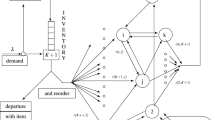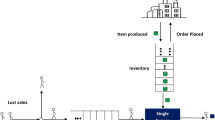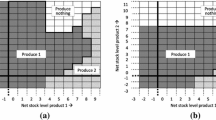Abstract
We present methods and tools for modeling autonomously controlled production networks and investigation of their stability properties. Production networks are described as interconnected dynamical systems of two types: systems of ordinary differential equations and time-delay systems. In particular with the help of time-delays, we incorporate transportation times and implement an autonomous control method, namely the queue length estimator. By stability, we mean roughly speaking, boundedness of the state of a system (e.g., the inventory level or the work in progress) over the time under bounded external inputs. In our stability analysis, we consider the case, when all the subsystems describing logistics locations are stable. We derive sufficient conditions that guarantee stability of the network. To this end, we utilize Lyapunov functions and a small gain condition.








Similar content being viewed by others
References
Alvarez E (2007) Multi-plant production scheduling in SMEs. Robot Comput Integr Manuf 23(6):608–613
Armbruster D, de Beer C, Freitag M, Jagalski T, Ringhofer Ch (2006) Autonomous control of production networks using a pheromone approach. Phys A 363(1):104–114
Bernstein DS (2009) Matrix mathematics: theory, facts, and formulas, 2nd edn. Princeton University Press, Princeton
Dai JG (1995) On positive Harris recurrence of multiclass queueing networks: a unified approach via fluid limit models. Ann Appl Prob 5(1):49–77
Dai JG, Weiss G (1996) Stability and instability of fluid models for reentrant lines. Math Oper Res 21(1):115–134
Dai JG, Vande Vate JH (2000) The stability of two-station multitype fluid networks. Oper Res 48(5):721–744
Dashkovskiy S, Görges M, Naujok L (2009) Local input to state stability of production networks. In: Proceedings of the second international conference on dynamics in logistics, LDIC 2009, Springer, Bremen, Germany, pp 79–89
Dashkovskiy S, Kosmykov M, Naujok L (2010) ISS of interconnected impulsive systems with and without time-delays. In: Proceedings of the 8th IFAC NOLCOS, Bologna, Italy, Sep. 01–03, 2010, pp 831–836
Dashkovskiy S, Naujok L (2010) Lyapunov-Razumikhin and Lyapunov-Krasovskii theorems for interconnected ISS time-delay systems. In: Proceedings of the 19th MTNS 2010, Budapest, Hungary, July 5–9, pp 1179–1184
Dashkovskiy S, Rüffer BS, Wirth FR (2007) An ISS small gain theorem for general networks. Math Control Sig Syst 19(2):93–122
Dashkovskiy SN, Rüffer BS (2010) Local ISS of large-scale interconnections and estimates for stability regions. Syst Control Lett 59(3–4):241–247
Dashkovskiy SN, Rüffer BS, Wirth FR (2010) Small gain theorems for large scale systems and construction of ISS Lyapunov functions. SIAM J Control Optim 48(6):4089–4118
De Leenheer P, Angeli D, Sontag ED (2007) Monotone chemical reaction networks. J Math Chem 41(3):295–314
Khalil HK (2002) Nonlinear systems. Prentice Hall, New York
Kim J-H, Duffie NA (2004) Backlog control for a closed loop PPC system. Ann CIRP 53(1):357–360
Liberzon D (2003) Switching in systems and control. Birkhäuser, Boston
Pepe P, Jiang Z-P (2006) A Lyapunov-Krasovskii methodology for ISS and ISS of time-delay systems. Syst Control Lett 55(12):1006–1014
Sauer J (2006) Modeling and solving multi-site scheduling problems. In: Wezel W, Jorna R, Meystel A (eds) Planning in intelligent systems aspects: motivations and method. Wiley, New York, pp 281–299
Scholz-Reiter B, de Beer C, Freitag M, Jagalski T (2007) Analysing the dynamics caused by autonomously controlled logistic objects. In: ElMaraghy HA, Zaeh MF (eds) Proceedings of 2nd international conference on changeable, agile, reconfigurable and virtual production (CARV 2007). Windsor, pp 273–280
Scholz-Reiter B, de Beer Ch, Jagalski Th (2007) Selbststeuerung logistischer Prozesse in Produktionsnetzen. Ind Manag 23(1):19–23
Scholz-Reiter B, Freitag M, de Beer C, Jagalski T (2005) Modelling dynamics of autonomous logistic processes: discrete-event versus continuous approaches. CIRP Ann Manuf Technol 54(1):413–416
Scholz-Reiter B, Görges M, Jagalski T, Mehrsai A (2009) Modelling and analysis of autonomously controlled production networks. In: Proceedings of the 13th IFAC symposium on information control problems in manufacturing (INCOM 09). Moscow, Russia, pp 850–855
Scholz-Reiter B, Jagalski T, Bendul J (2008) Autonomous control of a shop floor based on bee’s foraging behaviour. In: Haasis H-D, Kreowski H-J, Scholz-Reiter B (eds) Proceedings of the 1st international conference on dynamics in logistics. LDIC 2007. Springer, Berlin, pp 415–423
Scholz-Reiter B, Wirth F, Freitag M, Dashkovskiy S, Jagalski T, de Beer C, Rüffer B (2006) Some remarks on the stability of manufacturing logistic networks. In: Haasis H-D, Kopfer H, Schönberger J (eds) Operations research proceedings 2005. Springer, Berlin, pp 91–96
Scholz-Reiter B, Wirth F, Dashkovskiy S, Makuschewitz T, Kosmykov M, Schönlein M (2009) Application of the pagerank algorithm for ranking locations of a production network. In: 42nd CIRP conference on manufacturing systems, Grenoble, France, June 3–5, 2009, Proceedings CD
Sontag ED (1989) Smooth stabilization implies coprime factorization. IEEE Trans Automat Control 34(4):435–443
Teel AR (1998) Connections between Razumikhin-type theorems and the ISS nonlinear small gain theorem. IEEE Trans Automat Control 43(7):960–964
Wiendahl H-P, Lutz S (2002) Production in networks. Ann CIRP Manuf Technol 51(2):1–14
Windt K (2006) Selbststeuerung intelligenter Objekte in der Logistik. In: Vec M, Hütt M, Freund A (eds) Selbstorganisation Ein Denksystem für Natur und Gesellschaft. Böhlau Verlag, Köln, pp 11–12
Windt K, Böse F, Philipp T (2005) Criteria and application of autonomous cooperating logistic processes. In: Gao JX, Baxter DI, Sackett PJ (eds) Proceedings of the 3rd international conference on manufacturing research. Advances in manufacturing technology and management
Acknowledgments
Sergey Dashkovskiy, Michael Görges, Andrii Mironchenko and Lars Naujok are funded by the German Research Foundation (DFG) as part of the Collaborative Research Centre 637 “Autonomous Cooperating Logistic Processes: A Paradigm Shift and its Limitations”. Michael Kosmykov is funded by the Volkswagen Foundation (Project Nr. I/82684 “Stability, Robustness and Approximation of Dynamic Large-Scale Networks - Theory and Applications in Logistics Networks”).
Author information
Authors and Affiliations
Corresponding author
Rights and permissions
About this article
Cite this article
Dashkovskiy, S., Görges, M., Kosmykov, M. et al. Modeling and stability analysis of autonomously controlled production networks. Logist. Res. 3, 145–157 (2011). https://doi.org/10.1007/s12159-011-0049-6
Received:
Accepted:
Published:
Issue Date:
DOI: https://doi.org/10.1007/s12159-011-0049-6




